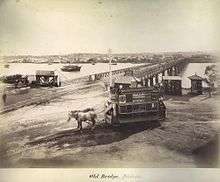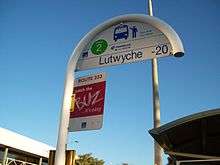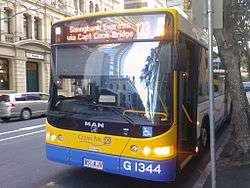Brisbane Transport
 | |
|
| |
| Parent | Brisbane City Council |
|---|---|
| Founded | 1925 |
| Service area | Brisbane |
| Service type | Bus services |
| Depots | 7 |
| Fleet | 1,192 (January 2015) |
Brisbane Transport is a business unit of Brisbane City Council, operating bus services under the TransLink integrated public transport scheme in Brisbane.
History

The origins of Brisbane Transport can be traced to August 1885 where the Metropolitan Tramways & Investment Company established a service in Brisbane under franchise from the Queensland Government with 18 horse trams. The tram system remained in private hands until January 1923 when the Queensland government established the Brisbane Tramways Trust, compulsorily acquiring the tram network and supporting infrastructure, then in 1925 creating the Brisbane City Council and transferring responsibility for the tram network to the council. Before the council withdrew support in 1961, the council supported the tram network by expanding it to a peak of 175 kilometres (109 mi) with over 400 trams.[1]
Bus services commenced in 1925 by the Brisbane City Council.[2] Brisbane City Council shut down bus services due to financial loss in November 1927. Bus services recommenced 13 years later, in July 1940 with 12 Albion Valkyries.[2][3] In 1948 the Brisbane City Council acquired 20 operators with 67 buses.[1]
The first Rocket services began on the morning of 18 April 1977 between Garden City and the Brisbane CBD.[4] These services were based on the idea that bus travel time could be reduced to less than the travel time by car by the removal of most embarkation stops.
In the 1990s, Brisbane City Council corporatised its transport services to form Brisbane Transport, a council-owned commercial businesses managed at arm's length from the council and providing consultancy services back to it. In 2010 however government and Brisbane City Council support for public transport have never been higher with over 1,061 buses in service, Translink, construction of key infrastructure such as busways and upgrade of key infrastructure.
Infrastructure
Brisbane Transport operates services along dedicated busway infrastructure to avoid peak hour traffic congestion on roads closest to the Brisbane CBD.
Services
Bus upgrade zone

Bus upgrade zones (BUZ) are high-frequency bus routes mostly running direct to the Cultural Centre. All BUZ services run at least every fifteen minutes from around 06:00 to 23:00 seven days a week and at least every ten minutes during peak hours from Monday to Friday.[5][6]
CityGlider
CityGlider is a high frequency pre-paid bus service around the Brisbane CBD, operating every five minutes during peak and every 10 to 15 minutes during off-peak. This is the first service in Brisbane to operate 24 hours on Friday and Saturday and 18 hours every other day.[7] Bus stops serviced by the CityGlider are identified with signs and painted kerb.
Clem7
Clem7 (Route 77) is a bus route using the Clem Jones Tunnel (Clem7) which links the suburbs of Eight Mile Plains and Chermside, the route runs every 15 minutes at peak times and 30 minutes at off-peak, Monday to Friday.[8]
The route commenced on 22 March 2010 at a cost of $1.6 million per annum. The route has decreased the journey time between Eight Mile Plains and Chermside, removing the need to transfer buses at Cultural Centre. The route completes the 30 kilometres (19 mi) cross-city journey in 39 minutes instead of up to 55 minutes via the Brisbane CBD.[8]
Fleet
As at January 2015, the fleet consisted of 1,192 buses.[9]
Two-axle buses
Almost a third of the total fleet are MAN 18.310s, delivered from 2005 to 2010, mostly with CNG engines. The rest of the regular rigid fleet consists of diesel-powered Volvo B7RLEs (delivered from 2010 on), CNG-powered Scania L94UBs (2000–2005), and smaller numbers of older Mercedes-Benz OC500LEs and Volvo B10Ls, all low-floor, accessible and air-conditioned.
Three-axle buses
BT operates two models of three-axle "tag" buses, the Scania K310UB (2008) and the Volvo B12BLE, both diesel-powered and delivered from 2008 on. These larger buses are used on high-demand trunk routes, mostly on the South East Busway.
Articulated buses
The only articulated buses currently used by BT are the CNG-powered MAN NG313s, delivered from 2005 to 2008.
Historic
Until the mid-1970s, heavy-duty AEC and Leyland buses were purchased. Later purchases were from European suppliers, Volvo B59s being purchased from 1976, MAN SL200s in 1982 and Volvo B10Ms from 1987.[1]
Depots
Brisbane Transport operates its services from seven depots for specified areas. Some of these depots service routes shared in overlapping areas with other depots. Generally, each of Brisbane Transport's buses is allocated to a particular depot, displays a letter prefix for that depot before its fleet number, and hence is assigned to specific routes.
| Depot | Letter Code | Location | Opened[10] | Closed | CNG Fuelling | Services / Comments |
|---|---|---|---|---|---|---|
| Carina | C | 27°29′25″S 153°06′07″E / 27.490371°S 153.102078°E | 1969 | - | No | All eastern routes and some south-eastern routes from Garden City to Wynnum and Bulimba |
| Eagle Farm | E | 2013 | - | No | Some northern routes; all routes between New Farm and West End. | |
| Garden City | G | 27°34′00″S 153°05′12″E / 27.56655°S 153.086731°E | 1994 | - | Yes | South-eastern routes from Browns Plains and Sunnybank to Wishart and Coorparoo. This depot is also the location of Brisbane Transport's head office. |
| Sherwood | S | 2012 | - | No | Western, south-western and north-western routes. | |
| Toowong | T | 27°28′45″S 152°59′01″E / 27.479235°S 152.983482°E | 1967 | – | Yes | South-western and north-western routes from Brookside and The Gap to Inala and Forest Lake. |
| Virginia | V | 27°21′57″S 153°03′39″E / 27.365889°S 153.060885°E | 1998 | - | Yes | Most northern routes from Nudgee Beach and Brighton to Brookside and the Gap. |
| Willawong | W | 27°35′55″S 153°00′15″E / 27.598531°S 153.004103°E | 2009 | - | Yes | Primarily southern routes, some shared with other southern depots. |
| Bowen Hills | A | 27°26′10″S 153°02′32″E / 27.435975°S 153.042313°E | 2000 | 2013 | No | Some northern routes; all routes between New Farm and West End. Closed in 2013 with the opening of the new depot at Eagle Farm. |
| Richlands | R | 27°36′05″S 152°57′27″E / 27.601259°S 152.957395°E | 1997 | 2013 | No | A satellite depot of the Toowong depot, it shared services on western routes, and some services to Garden City. |
| Larapinta | L | 27°38′35″S 153°00′27″E / 27.643171°S 153.007364°E | 2007 | 2012 | No | A satellite depot of Carina, Garden City and Willawong depots, it shared southern, western and eastern services. Originally a temporary bus depot until the Willawong depot opened, it remained open as a satellite depot, sharing routes with other southern depots, until 20 February 2012. |
| Bracken Ridge | B | 27°19′54″S 153°01′47″E / 27.331658°S 153.02982°E | 1996 | 2001 | No | Only ever intended as a short-term depot, it was closed in 2001, several years after the Virginia depot had opened. |
| Cribb Street, Milton | - | 27°28′09″S 153°00′28″E / 27.469226°S 153.007858°E | ? | 1983 | No | Never a formal depot, the site was occasionally used as temporary storage for buses owing to its proximity to the Milton bus and tram workshops. Last used in 1983. |
| Ipswich Road, Woolloongabba | - | 27°29′22″S 153°02′09″E / 27.489505°S 153.035731°E | 1969? | 1974 | No | Originally shared with trams. Buses parked in the depot forecourt and at the rear (eastern end) of the tram sheds. Between 1969 and 1974, the depot was used solely by buses. The site was subsequently sold by the Brisbane City Council for commercial redevelopment. One bay of the depot building was dismantled and re-erected at the Brisbane Tramway Museum at Ferny Grove. |
| Light Street, Newstead | L | 27°27′05″S 153°02′19″E / 27.451323°S 153.038617°E | 1885 | ? | No | Closed for commercial redevelopment. First used as a depot in 1885 when it was the main tram depot for Brisbane's horse tram network. Until 1968, buses shared the depot with trams, the buses being parked along the western (Wickham Street) frontage and north of the tram shed. When the tram shed was demolished, buses were parked where the shed once stood. |
| Milton | - | 27°28′02″S 153°00′34″E / 27.467217°S 153.00958°E | ? | 1969 | No | Shared with trolleybuses and closed when the trolleybus network was abandoned in 1969. The site is now part of the King's Row business park, although the Brisbane City Council still has a parks works depot there. |
See also
References
- 1 2 3 Birrell, RA (1987). Brisbane City Council Bus Fleet. Elizabeth, South Australia: Railmac Publications. pp. 4–6. ISBN 0 949817 66 X.
- 1 2 Mass transit investigation report (PDF). Brisbane City Council. September 2007. p. 17. Retrieved 14 April 2010.
- ↑ Manfred, Cross (1997), "Alfred James Jones: Labor's first lord mayor", in Shaw, Barry, Brisbane:Corridors of Power, Papers, 15, Brisbane: Brisbane History Group, p. 158, ISBN 0-9586469-1-0
- ↑ Cole, John R (1984). Shaping a city. Albion: William Brooks Queensland. p. 330. ISBN 0-85568-619-7.
- ↑ BUZ network map (PDF) (Map). TransLink. Retrieved 15 April 2010.
- ↑ "TransLink Bus Timetables". Retrieved 15 April 2010.
- ↑ Trenwith, Courtney (11 April 2010). "Brisbane's 24-hour buses hit the road". Brisbane Times. Retrieved 18 December 2010.
- 1 2 Minister for Transport Rachel Nolan (1 March 2010). "77 in Clem 7 crosses north-south divide". Ministerial Media Statements. Queensland Government. Retrieved 16 April 2010.
- ↑ Bus Fleet Allocation - Summary Brisbane Transport Buses
- ↑ Otto, Patrick. "About BT". Retrieved 1 January 2013.
